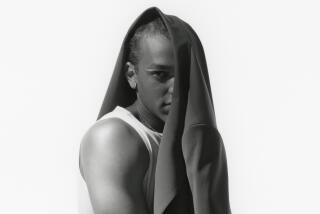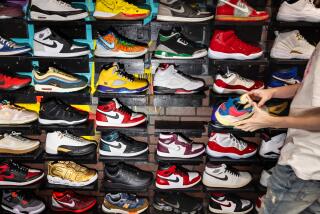Where the Shoe and the Price Are Made to Fit
- Share via
HONG KONG — Seasoned travelers unanimously agree that among the essentials for pleasurable travel are comfortable shoes. Keep in mind that regardless of designer label or high price, few shoes fit without a painful breaking-in period and during a trip is not the time to have to endure aching feet.
Many well-heeled shoe fanatics know that no footwear fits as perfectly as that which is made to measure. But alas, custom-order shoes at John Lobb in London or Hermes in Paris, Oliver Moore in New York and other famous cobblers in various shopping capitals cost about $700 or more, putting them beyond the budget limitations of most shoppers.
In Hong Kong, price tags for custom-made shoes may be as high as $400 to $500 a pair, but there are also dozens of excellent cobblers who make custom shoes in a wide range of styles and leathers priced less than off-the-shelf designer labels at home. High quality and low cost make Hong Kong a mecca for shoe shoppers, regardless of their budgets.
At Lily Shoes Manufacturing Co., for example, $145 buys beautiful made-to-measure women’s pumps or men’s loafers of fine leather or supple suede in a wide choice of colors and with a variety of optional details. The same pair of shoes in crocodile or other exotic leathers might cost about $410. Men’s or women’s custom-made knee-high leather boots are about $285, and women’s sturdy leather walking shoes are about $145.
Lily is among the most highly recommended shoemakers in Hong Kong. The shop is tucked away in a relatively quiet corner on the Peninsula Hotel’s mezzanine shopping arcade (13 Mezzanine, West Wing, Salisbury Road, Tsimshatsui, phone 721-5910). It has a long list of regular customers, including jet setting Peninsula Hotel guests, businessmen and flight attendants who visit Hong Kong regularly, as well as tourists who visited once and continue to order shoes by mail from home.
The glass-fronted shop is without much show, but inside, three walls are lined floor-to-ceiling with shelves filled with shoe samples. Styles for both men and women tend to be conservative and classical. Women’s pumps, for example, feature slender 2 1/2 to three-inch heels, fashionable vamps and a rich array of details including pleats, bows and buckles or top-stitching and two-tone effects. Men’s loafer’s can be made casual or dressy and oxfords are plain or wing-tipped.
Of course, with custom-made shoes, all shapes, heel heights and other details can be altered to your liking. There is also the option of taking in a pair of old favorites or a fashion magazine photo of shoes that you would like to have copied.
Once you’ve selected the style, you sit down with thick books containing swatches of leathers from delicate kid and sturdier calf skins to crocodile, alligator, ostrich, snake and lizard, buffalo and other exotic leathers.
When selecting an exotic skin, make sure it does not come from a protected species because the Endangered Species Act prohibits items made from these skins from being brought into the United States. If you have any doubts about the type of skin you’re thinking of selecting for your shoes, inquire at the U.S. Consulate (26 Garden Road, Central District, phone 523-9011) before ordering.
The extraordinary palette of colors displayed in the books of swatches ranges from basics to flamboyant fuchsias and pastel pinks, earthy ochers and gorgeous greens. Fortunately, Lily’s staff is both accommodating and patient. Based on their extensive experience, they’ll suggest that certain styles be made with different types of skins or in particular colors.
According to Lily’s manager, Mr. Wong, shoes that are copied look slightly different from the originals or the photos. “We are making shoes to exactly fit the proportions of your own foot,” Wong explained. “The distance from the toes to the instep is different on every foot, so the proportions of the shoe will also be different. But the shoes will be more comfortable and they last longer because the feet are putting equal stress on all parts of the upper leather.
“Also, our heel might be different. We have very nice elegant heels, but we do not offer every shape of unusual heels as we explain to our customers when they order the shoes. Of course, we can make any style, but sometimes it is better for a first-time customer to order our styles, the ones that we show, to avoid disappointment. When they understand better the differences between ready-made and custom-made shoes, they can experiment more.”
The measuring is a simple 15- to 20-minute process. The salesman carefully draws an outline of each foot and then measures the area across the toes and instep, the height of the arch and instep and the distance from sole to anklebone, among other things.
At the first fitting, which usually takes place two days later (but can be arranged for the next day if you’re pressed for time), you try on a sturdy canvas mockup of the shoe you’ve ordered to see if any points pinch or rub your foot. If they do, necessary adjustments will be indicated on the mockup. Unless there are major changes to be made or your feet are very hard to fit, one appointment is usually sufficient.
Your personal last, a wooden foot shaped to the measurements of your foot, is made from this mockup. The last can be used repeatedly, as long as you order shoes with the same heel height. If you change heel heights, you need a different last. Lily keeps your lasts on file so the shop can fill mail orders for additional shoes.
For a first pair of custom-made shoes at Lily or any other shop, it is best to be there to try on the finished product, rather than have them shipped home. Although shoes can be made start to finish within four days, most shops suggest allowing a week for the process to assure a better fit and better workmanship.
One fairly frequent complaint among custom-shoe customers in Hong Kong is that finished shoes are not made from the same quality of leather as the swatches that have been selected. To avoid this, ask to see the skin from which your shoes will be made. Lily and other reputable cobblers will gladly accommodate this request, although you may have to wait until the skin can be brought to the shop from the factory. If the cobbler refuses to show you the skin before making your shoes, you should probably shop elsewhere.
Another consideration is the degree of tightness on the initial fit. Very supple leather and suede shoes stretch, and you might want them to fit quite snugly at first. Heavier leathers do not stretch as quickly or as much, and if they are snug at first they might remain snug forever.
Lily is recommended by the Hong Kong Tourist Assn. (HKTA), which runs quality control checks on cobblers (as well as other types of shops) and gives those who qualify the right to display the HKTA’s red junk logo, always a reassuring sign for customers.
Prices quoted in this article reflect currency exchange rates at the time of writing.
More to Read
Sign up for The Wild
We’ll help you find the best places to hike, bike and run, as well as the perfect silent spots for meditation and yoga.
You may occasionally receive promotional content from the Los Angeles Times.






